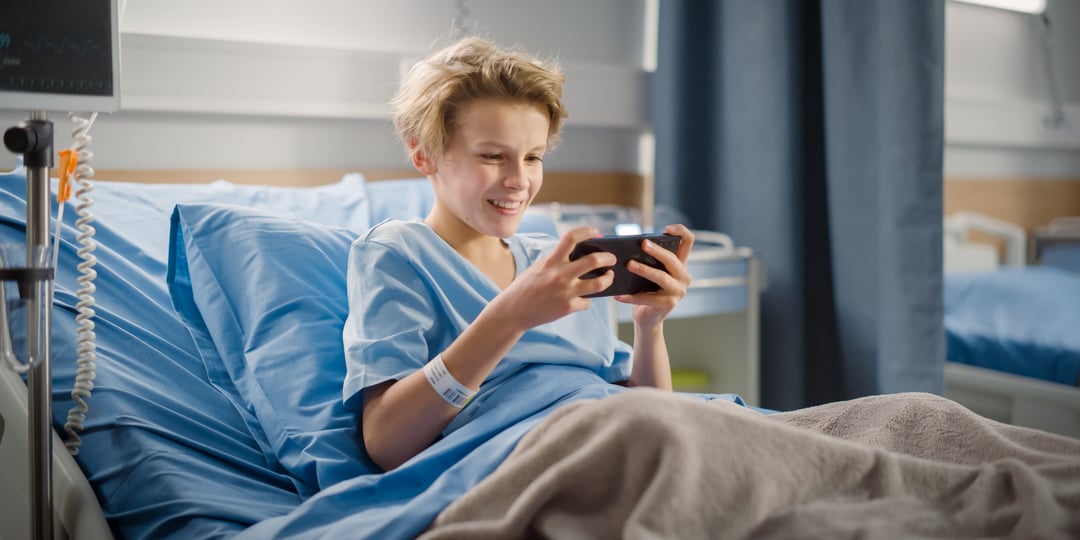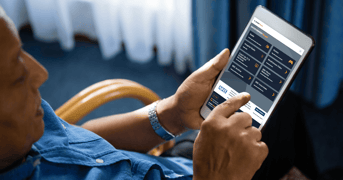What It's Like Being a Patient in Hospital
4 minute read | 07/07/2022

WiFi SPARK is here for patients in hospital. I find out more about their needs and how our services can help through interviewing previous patients. Not everyone has had the experience of being a patient in hospital after all.
Steve’s story
Everyone’s experiences are different. Steve had a very serious heart condition, with a 1 in 4 survival rate. He was in hospital for three weeks and felt numb. He made peace with his chances of survival. He was kept busy with the routines of the hospital day and used a personal device for entertainment in the evening. He could call his family and was lucky to have regular visitors. Yet a few weeks after he was discharged, he was feeling unwell again and was driven to the hospital. He became very upset because he felt like he had failed after thinking it was all over. Thankfully, it turned out to be a minor issue and he is now happy and healthy.
When he was in hospital, there was one night where the older patient next to him had an impeding sense of doom and he called out “I’m dying, someone help me.” His strong emotion had a ripple effect on the rest of the ward, making them think that perhaps they should be worrying about the same thing. This older patient had no access to an electronic device. No bedside unit, not even a tablet like Steve had. He must have felt very isolated.
Laura’s story
Laura was in hospital for a week with her four year old daughter. This was when there were strict covid measures. Only one parent was allowed to stay in hospital with her and they weren’t allowed any visitors. Laura expressed her primary feelings as anxious, worried, but glad her child was in the right place, getting the help she needed. Her daughter, on the other hand, was really emotional because she had never been separated from the rest of her family like this before. All she wanted was to see and talk to her daddy. Laura noted that “young children aren't very good on the phone. They they're much better when they can visualise. Having FaceTime or the equivalent was quite important.” But at the time, the hospital Wi-Fi was a basic service, and therefore, not good enough for video calling. This only added to her daughter’s distress.
Sarah’s story
Sarah is regularly in and out of hospital with her son, who has a life-limiting lung disease. It’s an unfortunate case that her and her son have been forced to get used to. But that doesn’t mean that they’re not worried when they’re in hospital and need something to take their mind off it. They do their best to live a normal life, but those hospital visits bring them back to their unfortunate reality.
What I discovered
What did I find out about their experiences? These patients need entertainment and communication to distract them from their condition and keep them connected with loved ones. Sarah says that entertainment isn’t “just important, it’s essential. Especially with a young child. It's the only thing that's going to distract them.” Laura agreed with her statement. They need devices that can bring some normality back into their lives by watching their favourite TV shows and movies. They don’t engage well with arts and crafts like the ones that were brought to Laura’s daughter. Entertainment also makes the evenings go by quicker, when it starts to get dark, and the daytime staff go home. They also wanted to be loved, supported, and connected to friends and family, making video calling a key factor.
Essentially, being a patient in hospital draws some similarities to when we were all stuck inside during the main wave of covid, and when we had to isolate after that. What would you do if you your WiFi was poor and you couldn’t stream your favourite shows? Or for the elderly population, if they didn’t have an electronic device to connect them to their family?
Understanding the importance of engagement in this way highlights that we need this technology available to patients. Currently in over 160 hospitals, bedside units from provider Hospedia have some of these features that solve the problem of entertainment in the hospital.
Steve said they “would be brilliant for those who didn’t know they were going to be in hospital for a while, so that they don’t have to bring anything or buy their own device.” Such as for those elderly patients who are likely to have more hospital visits and not own their own device.
How our services and products can help
SPARK® Horizons (new state-of-the-art bedside units replacing legacy units in hospitals) will have all of the current features of existing Hospedia units, such as the telephony, dementia orientation screen, patient safety video, radio services, television etc, as well as new features from SPARK® Media, blended into one platform. SPARK® Horizons will feature all the previous, plus video calling, games, access to lots of streaming services like Netflix and Disney plus, NHS applications, parking, Dementia support, communication aids, mental health services, more entertainment options and so much more.
Extensive entertainment options from this technology will distract patients from their conditions. It’s a modernised bedside unit that caters for all age groups and will solve all the issues these patients have had while in hospital. The best part is that all of these services will be free to the patient by 2024.
So, what are you waiting for? Find out more about how you can utilise existing Hospedia bedside units to help your patients, or invest in our upcoming product, SPARK® Horizons.
About the author
Rebecca O'Donovan
Becky is the Marketing Director at SPARK TSL, of whom she has worked for since 2012. She is responsible for high-level marketing strategy focusing on lead generation and aiding the vision of the business to ensure business growth.
More articles by the author
Related articles
 Healthcare Industry
Healthcare Industry
5 Benefits of Patient Education Systems for Hospitals
 Healthcare Industry
Healthcare Industry
Delivering Patient-Centred Care With the Technology | SPARK TSL
At its core, healthcare is about the patients — technology is simply an enabler. There’s so much more to ...
 The SPARK Solution
The SPARK Solution
Clinical Benefits of Hospedia Bedside Units and SPARK® Media
Hospedia Bedside Unit Clinical Benefits for Patients

